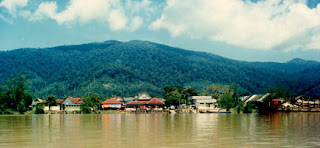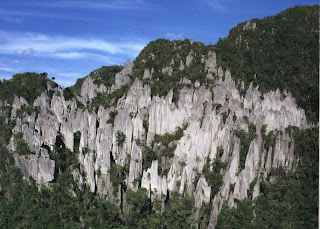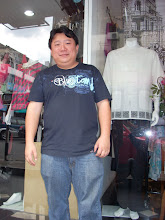


Otto’s Lundu Page
Information for the traveller, and appreciation of the place where we live.
This web-info, i get it from Otto's Lundu, not knowing him though, but cool, covers Lundu. Bravo Otto's.
http://www.ikanlundu.com/lundu/lundupage1.html
Gunung Gading becaban tiga,
Pantai Pandan jauh ka tengah.
Ancur badan di-kubur tanah
Budi baik di-kenang juga.
"Tusk Mountain has three peaks,
Pandan Beach stretches far to the middle.
A person's body may be dissolving in the grave;
A kind heart is remembered always."
---
as recited by the late Hbi anak Muda (our son Sam's grandmother).
The Arms of the Lundu District Council (
Majlis Daerah Lundu) : Above, Gunung Gading; a
Rafflesia; Pandan (and/or Siar) Beach, and water that can be both the Batang Kayan (Kayan River) and the South China Sea.
The town's "totem animal," from which it takes its name: an
ikan lundu, literally "
lundu-fish," a freshwater, bottom-feeder, catfish like thing,
"Arius or
Macrones species" (Anthony Richards,
An Iban-English Dictionary.) Photographed at the Sematan (alas) fish-market, 17 June 2005.
Introduction
Where Lundu Is. And How to Get There.
1° 40' N 109° 50' E
Lundu lies in the west of Sarawak, on the west bank of the Batang Kayan (Kayan River), and not far from the South China Sea. The road from Kuching to Lundu measures, all in all, about 90 km.
•
By car: From the center of Kuching, take Rock Road to Third Mile bazaar, and continue on Batu Kawa Road. At the time of writing (25 March 2004) Batu Kawa Road is being widened, so expect obstructions. Continue over the Sarawak River Bridge and straight to the end. Turn right (to the west) and drive straight on the Bau-Lundu road.
NEW! At last, the bridge that carries the main road over the Batang Kayan river is complete! It was opened on July 7, 2005. Travellers to Lundu will no longer have to wait for a ferry---a business that was tedious at the best of times and truly gruesome on holidays. I have seen a line
two miles long of cars waiting their turn to be carried over. Nobody is happier for having a bridge than us locals. Now we can do our shopping when we please.
Follow the signs. Once on the west bank of the river one can turn right and reach Lundu town by the road through the Malay kampong. Drive
slowly, children are playing, and watch for speed-bumps.
Note for those who get hungry: Half a mile before the Batu Kawa road joins the Bau-Lundu road, on the right/west side of the road, is the Red Dragon Café. The Red Dragon (the only non-Chinese dragon in the whole of Sarawak---it's Welsh) is the best local-style restaurant I know. The food is excellent, and the restaurant is spotlessly clean. The proprietors, Mr. Richard Hughes and Tata, his wife (the café is in her kampong) also serve the best British breakfast in the country, with
real pork sausages and bacon. Their conversation is fully as valuable as their cookery. Please tell them I sent you.
•
By bus: The Sarawak Transport Company runs four busses in each direction from the Kuching Express Terminal at 3 ½ Mile. Trip time is about one and a half hours. The Express-Bus Terminal is best reached by taxi.
| Kuching to Lundu
| Lundu to Kuching
|
| 8:15 a.m.
| 8:00 a.m.
|
| 11:00 a.m.
| 11:a.m.
|
| 2:00 p.m.
| 2:00 p.m.
|
| 4:00 p.m.
| 4:00 p.m.
|
One can also take a local bus from Kuching to Bau, and change at the bus station there to a local bus to Lundu. This is better for seeing interesting things out the window.
Places to Stay: Lundu and Sematan
1. Siar Beach Resort. Located at Siar Beach outside of Lundu, further down the road from Gunung Gading National Park.
From their advertisement in the
Sarawak Tribune:
"•Fishing • BBQ facilities • Fridge • Electricity
• Master Bedroom with air-conditioning and bathroom attached."
Telephone: 082-572300, mobile: 019-886 9478
2. Lundu Gading Hotel, Ang Yong Huat, manager. Located in the center of Lundu town, across from RHB Bank.
Lot 174, Lundu Town District
94500 Lundu, Sarawak
Tel/Fax: 082-735199
Mobile: 019-858 6529
Room rates: RM 58.00 per room per night. Air-conditioning, bathroom/toilet, TV.
14 rooms in all: 12 rooms with 2 single beds, 2 rooms with double bed.
3. Gunung Gading National Park
Trekkers will probably wish to put up here. The chalets and other rooms are right in the park, and if you rise at dawn (always at 0630 or thereabouts throughout the year----we
are on the equator----you'll get in a full day's scampering over the mountains, with time at late afternoon for relaxation. Be advised that Gunung Gading N'tl Park is over a mile from Lundu town, and that busses to and fro can be caught only 500 m from the Park, on the main road, that they run infrequently, and cease in the mid afternoon.
The following information is taken from
http://www.forestry.sarawak.gov.my/forweb/np/np/gading.htm Please visit there for fullest information, including phone numbers for other national parks.
Gunung Gading Park has two chalets, each with three bedrooms, and one domitory-style hostel consisting of four rooms each containing 16 beds. Campsites are available.
• The "Forest Lodge" chalets offer a double bed in Room 1, and two single beds in each of the other two other rooms. The rooms are air-conditioned. The rate is RM150 per night.
• The "Forest Hostel" offers four rooms with two bunk-beds each. Bathroom and toilet is shared. The rooms are not air-conditioned. The rates are: RM15 per bed, or RM40 per room.
• A campsite, with access to bathroom and toilet, is available for RM5 per person. There are ten sites.
4. Sematan Hotel
A small, modest hotel on the main road into Sematan, about 500 m before the T-junction, on the left. Twenty-three rooms, with air-conditioning and shower, at RM25 per night. For food, you must go to the bazaar. Laundry can be done.
Tel/Fax: 082-711162
5. Sematan Palm Beach Resort. In Sematan, the furthest town to the west in Sarawak. To reach the Resort, take the road from Lundu to Sematan straight to its end in a T-junction in Sematan bazaar, turn left, and head west, allowing for bends and junctions in the road. If you stop in Sematan bazaar, inquire at the Hing Moh supermarket, on the corner after the fishmarket and bus-station.
I reproduce their brochure.-----------
Room Tariff (Effective 13.11.04)
| Room Types
| Eve of Holidays
& weekends
| Weekdays
|
| Detached Chalet (4 pax)
| RM330 nett
| RM280 nett
|
| Quadruplex Chalet (2 pax)
| RM180 nett
| RM153 nett
|
| Terrace Twin (2 pax)
| RM140 nett
| RM130 nett
|
| Terrace Family (6 pax)
| RM 390 nett
| RM331 nett
|
• Above rates include dinner & breakfast
• All rooms fully air-conditioned, equipped with TV and en-suite toilet cum bathroom with heater
• Check-in : 2 p.m. Check-out : 12 p.m.
• Deposit payable upon confirmation of rooms
• Group rates negotiable
• Above rates are nett, including of [sic] service charge and govt tax
• Rates are subject to change without prior notice
Other Facilities
• Conference room
• Restaurant
• Rental of BBQ pits RM15/unit
• Rental of Majong table RM15/unit
Recreation
• i. Kayak rental Single RM10 / hr Double RM15 / hr
ii. Bicycle rental RM 5 / hr
iii. Climbing wall RM5 / hr
iv. Diving, snorkeling Prior arrangement
• Non-stay-in guests
Entrance fee per day: Adult RM2 Child RM1
For reservation & inquiries
Sematan Palm Beach Resort
No. 12, Sematan Bazaar 94100 Sematan, Sarawak Tel: 082-712388, 082-711112, 082-7111128 Fax: 082-711177





 Mount Singai
Mount Singai (1843 ft or 562 m) is located in between Bau & Matang area. The Catholic memorial & pilgrimage centre is located in the middle of this small mountain.This is a rest area where you can pray. They build long houses, and community complex. Instead of becoming the Catholic Centre this place is also open for visitors, those who love nature.The locals and visitors work together to carry the stone and other material using 'tambok' . These materials are used to build the community center. You can also do your part by carrying plastic bags of stone. (they prepared bags contain stone at the first step)
Mount Singai
Mount Singai (1843 ft or 562 m) is located in between Bau & Matang area. The Catholic memorial & pilgrimage centre is located in the middle of this small mountain.This is a rest area where you can pray. They build long houses, and community complex. Instead of becoming the Catholic Centre this place is also open for visitors, those who love nature.The locals and visitors work together to carry the stone and other material using 'tambok' . These materials are used to build the community center. You can also do your part by carrying plastic bags of stone. (they prepared bags contain stone at the first step)











































